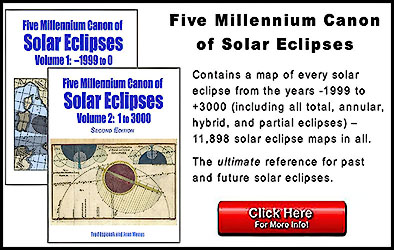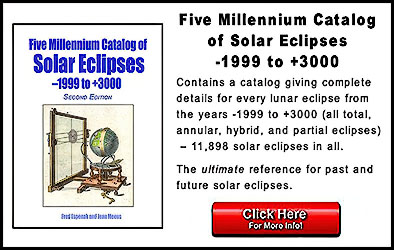Key to Catalog of Solar Eclipses
Fred Espenak
Each line in the Catalog of Solar Eclipses corresponds to a single solar eclipse and provides concise parameters to characterize the eclipse. The calendar date and Terrestrial Dynamical Time (TD) of the instant of Greatest Eclipse are given along with the adopted value of ΔT. The Lunation Number and the Saros series are listed along with the eclipse type (P=Partial, A=Annular, T=Total, or H=Hybrid). The quincena lunar eclipse parameter identifies the type of lunar eclipse that precedes and/or succeeds a solar eclipse. Gamma is the distance from the axis of the Moon's shadow the center of Earth at Greatest Eclipse, while the eclipse magnitude is defined as the fraction of the Sun's diameter occulted by the Moon at the geographic location and instant of Greatest Eclipse. The latitude and longitude of the geographic location of Greatest Eclipse are listed along with the Sun's altitude, the width of the central path and the duration of totality or annularity from that position. A more detailed description of each field appears in the Key to Catalog of Solar Eclipses below.
| Key to Catalog of Solar Eclipses | |
| Parameter | Description |
| Calendar Date | the calendar date of the eclipse at the instant of Greatest Eclipse; the Gregorian Calendar is used for dates after 1582 Oct 15, while the older Julian Calendar is used for prior dates; |
| TD of Greatest Eclipse | the Terrestrial Dynamical Time (TD) of the eclipse at the instant of Greatest Eclipse; |
| ΔT | a measure of the accumulated clock error due to variations in the rotation period of Earth; ΔT is difference between Terrestrial Dynamical Time (TD) and Universal Time (UT1) (i.e., ΔT = TD - UT1 ); |
| ΔT Sigma | a measure of the standard error in ΔT; values of ΔT in the distant past and in the future are extrapolations with an uncertainty reflected in the value of ΔT Sigma; |
| Luna Num | the Lunation Number of the synodic month in which the solar eclipse takes place; |
| Saros | the number of the Saros series to which the eclipse belongs; |
| Ecl Type | the Eclipse Type is a 2-character code that describes the classification of an eclipse; The first character describes the kind or category of the eclipse where:
|
| QLE | the Quincena Lunar Eclipse parameter identifies the type of lunar eclipse that precedes and/or succeeds a solar eclipse where:
|
| Gamma | the distance (in units of equatorial Earth radii) of the Moon’s shadow cone axis from the center of Earth at the instant of Greatest Eclipse; since this is the instant when the Moon’s shadow passes closest to the center of Earth, Gamma is, by definition, the minimum distance of the shadow axis from center of Earth; |
| Ecl Mag | the Eclipse Magnitude is the fraction of the Sun’s diameter occulted by the Moon at the instant of Greatest Eclipse; the Eclipse Magnitude is less that 1.0 for partial and annular solar eclipses; the Eclipse Magnitude is equal to or greater than 1.0 for total solar eclipses; |
| Lat | the Latitude is the geographic latitude where the axis of the Moon's shadow intersects with Earth's surface at the instant of Greatest Eclipse; for partial and non-central eclipses, it is the geographic latitude where the axis of the Moon's shadow passes closest to; |
| Long | the Longitude is the geographic longitude where the axis of the Moon's shadow intersects with Earth's surface at the instant of Greatest Eclipse; for partial and non-central eclipses, it is the geographic longitude where the axis of the Moon's shadow passes closest to; |
| Sun Alt | the Sun Altitude is the altitude of the Sun above the horizon from the geographic location and time of Greatest Eclipse; for partial and non-central eclipses, the Sun Altitude is 0° because the Sun is in the horizon; |
| Path Width | the width (in kilometers) of the path of totality or annularity from the geographic location of Greatest Eclipse; |
| Central Dur | the Central Duration is the duration (in minutes and seconds) of totality or annularity from the geographic location of Greatest Eclipse; |
Additional Solar Eclipse Links
- Home - home page of EclipseWise with predictions for both solar and lunar eclipses
- Solar Eclipses - primary page for solar eclipse predictions
- Solar Eclipse Links - detailed directory of links
- Six Millennium Catalog of Solar Eclipses - covers the years -2999 to +3000 (3000 BCE to 3000 CE)
- Javascript Solar Eclipse Explorer - calculate all solar eclipses visible from a city
Acknowledgments
Some of the data presented in the Catalog of Solar Eclipses were previously published in the Five Millennium Canon of Solar Eclipses: -1999 to +3000 and the Thousand Year Canon of Solar Eclipses 1501 to 2500. All eclipse calculations are by Fred Espenak, and he assumes full responsibility for their accuracy. Permission is granted to reproduce this data when accompanied by an acknowledgment:
"Eclipse Predictions by Fred Espenak, www.EclipseWise.com"




